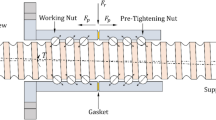Abstract
Wear is the main cause of the failure of the ball screw pair, which seriously affects its accuracy and service life. Therefore, it is necessary to build and analyze the wear model of ball screw pairs based on analyzing wear mechanism in depth. At present, the study of ball screw wear model mostly adopts the theory of adhesion wear. It is believed that the wear amount during normal wear period is proportional to time. But in fact, this conclusion cannot express the change of the whole wear process. Based on the wear mechanism of the ball screw pair, this paper deeply analyzes the influence of abrasive wear on the ball screw during the entire life cycle. And according to the Archard wear theory, a wear model considering the impact of abrasive particles is established. In this model, the wear of the ball screw pair is exponentially related to time. The experiments verify the applicability and accuracy of the model set out in this paper, which provides a theoretical foundation for the following research on the accuracy maintenance of ball screw pairs.
Access this chapter
Tax calculation will be finalised at checkout
Purchases are for personal use only
Similar content being viewed by others
References
Greenwood JA, Williamson JBPP (1996) Contact of nominally flat surfaces. Proc Roy Soc A Math Phys Eng Sci 295(1442):300–319
Chang WR, Etsion I, Bogy DB (1987) An elastic-plastic model for the contact of rough surfaces. ASME J Tribol 109(2):257–263
Horng JH (1998) An ellipticity elastic-plastic asperity microcontact model for rough surfaces. ASME J Tribol 120:82–88
Zhong Y, Tao WJ, Han J (2003) Research on precision loss model of ball linear guide pair. Modular Mach Tools Autom Process Technol (12):33–36 (2003) (in Chinese)
Xu XH, Tang WH, Yu T (2016) Ball screw wear prediction based on Archard theory. Combination Mach Tools Autom Process Technol 2:54–59 (in Chinese)
Liu CH, Chen XY, Gu JM (2009) High-speed wear life-time analysis of instrument ball bearings. Proc Inst Mech Eng Part J: J Eng Tribol 223(3):497–510
Olofsson U (1997) Characterization of wear in boundary lubricated spherical roller thrust bearings. Wear 208(1–2):194–203
Wen SZ, Ping H (2012) Principles of tribology (2nd edn). Tsinghua University Press, Beijing, pp 301–340 (in Chinese)
Archard JF (1953) Contact and rubbing of flat surfaces. J Appl Phys 24(8):981–988
Rabinowicz E, Dunn LA, Russell PG (1961) A study of abrasive wear under three-body conditions. Wear 4(5):345–355
Gui CL (1990) Archard’s wear design calculation model and its application method. Lubr Eng 1:12–21 (in Chinese)
Bayer RG, Clinton WC, Sirico JL (1964) A note on the application of the stress dependency of wear in the wear analysis of an electrical contact. Wear 7(3):282–289
Gao HQ, Cai HJ, Cai M (2018) Finite element analysis of angular contact ball bearing wear based on archard modified model. Mach Tool Hydrau Pressure 46(15):159–164 (in Chinese)
Wang N (2008) Physical characteristics of wear faults of low-speed bearings based on fractal-wavelet analysis. Northeast University (in Chinese)
Acknowledgements
This work is supported by the National Natural Science Foundation, China (No. 51835001; 51705048); the National Major Scientific and Technological Special Project for “High-grade CNC and Basic Manufacturing Equipment,” China (2018ZX04032-001).
Author information
Authors and Affiliations
Corresponding author
Editor information
Editors and Affiliations
Rights and permissions
Copyright information
© 2020 Springer Nature Singapore Pte Ltd.
About this paper
Cite this paper
Li, Q., Liu, Y., Zhang, G., Ran, Y. (2020). Study on Ball Screw Wear Model Considering the Influence of Abrasive Particles. In: Jia, L., Qin, Y., Liu, B., Liu, Z., Diao, L., An, M. (eds) Proceedings of the 4th International Conference on Electrical and Information Technologies for Rail Transportation (EITRT) 2019. EITRT 2019. Lecture Notes in Electrical Engineering, vol 638. Springer, Singapore. https://doi.org/10.1007/978-981-15-2862-0_1
Download citation
DOI: https://doi.org/10.1007/978-981-15-2862-0_1
Published:
Publisher Name: Springer, Singapore
Print ISBN: 978-981-15-2861-3
Online ISBN: 978-981-15-2862-0
eBook Packages: EngineeringEngineering (R0)




